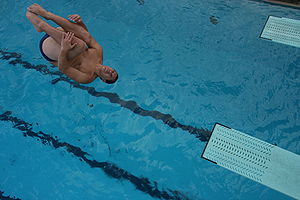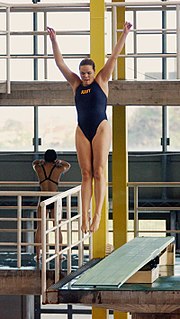The fundamental item of diving equipment used by divers is the SCUBA equipment, such as the Aqualung or Rebreather. There are other important pieces of equipment that make diving safer, more convenient or more efficient.
Personal Diving Equipment
Scuba life support
- Open-circuit Scuba consisting of diving cylinder(s) and diving regulator(s)
- Rebreather, closed-circuit or semi-closed-circuit Scuba
Alternative life support
- Liquid breathing systems are extremely rare and at an early experimental stage. It is hoped that some day practical systems allow very deep diving.
- Snorkel allows breathing at the surface with the face submerged.
- Standard diving dress - mostly used in professional diving. Merely of historical interest now.
- Surface supplied diving - mostly used in professional diving, except recreational forms like snuba.
Thermal, sting and abrasion protection
- In cold water, a diving suit such as a dry suit or a wet suit
- In very warm water, many types of tough, long, everyday clothing provide protection, as well as purpose made garments such as dive skins and shorty wetsuits
- Diving gloves, neoprene is often used for thermal insulation
- Diving boots, often made of neoprene and rubber
- Safety helmet for scuba diving. Not air-holding. May have a built-in forehead light. Images at [1].
In-water stabilisation and movement
- A backplate is a structural device linking the buoyancy of the wing with the weight of the diving cylinders and harnessed around the diver's body
- Buoyancy compensator, Buoyancy Control Device, BCD or BC - many names for a buoyancy adjusting and life-saving buoyancy device
- Diver Propulsion Vehicle - to increase the range of the diver undwerwater
- Diving weighting system - to counteract the buoyancy of the diving suit and diver to allow descent
- Fins for efficient propulsion
Measurement and navigation
- Compass for underwater navigation
- Decompression tables to avoid decompression sickness
- Depth gauge is used with watch for decompression monitoring on decompression tables
- Distance line is used to navigate back to the start point in poor visibility
- Dive Computer to avoid decompression sickness
- Watch is used with depth gauge for decompression monitoring on decompression tables
Vision and communication
- Mask allows the diver to see clearly underwater and protects the eyes.
- Full face mask protects the face from dirty or cold water and increases safety by securing the gas supply to the diver's face. If it contains no mouthpiece, the diver can talk allowing the use of communications equipment.
- Diving helmets are often used with surface supplied diving. They provide the same benefits as the full face mask but provide a very secure connection of the gas supply to the diver and additionally protect the head.
- Underwater writing slates and pencils are used to transport pre-dive plans underwater, to record facts whilst underwater and to aid communication with other divers.
- Torchs / flashlights are essential for safety in low visibility or dark environments such as night diving and wreck and cave penetration. They are useful for communication and signalling both underwater and on the surface at night. Divers need artificial light even in shallow and clear water to reveal the red end of the spectrum of light which is adsorbed as it travels through water.
- Hand-held sonar for a diver.
Tools

- Airlift - a gas "powered" tube that is used in nautical archaeology, which vacuums small objects, sand and mud from the sea bed
- Camera and housing - for underwater photography or underwater videography
- Decompression trapeze consists of one or more horizontal bars, suspended at decompression stops by buoys
- Diving reel to transport a distance line or line for a surface marker buoy
- Diving shot consisting of a weight, line and buoy used to mark the location of a dive site, allowing divers to navigate to and from the surface and to do decompression stops at a safe location
- Dry box to hold objects the diver needs to keep dry at depth (wallet, cell phone)
- Knife to cut lines, nets or to pry or dig. Can also be used for personal protection against underwater predators if needed, however not recommended.
- Lifting bag - to lift heavy objects underwater activated by adding air
Surface detection aids
The purposes of this class of personal equipment are to:
- allow the support boat to monitor and find divers on the surface during or after a dive
- prevent the diver being struck by boat traffic
- mark the diver's position when drift diving or while at the decompression stop
- help rescue services in lifeboats and helicopters to locate the diver
Surface detection aids (with cheapest and most effective towards the top) include:
- Surface Marker Buoy, Decompression buoy, Delayed SMB, safety sausage or blob
- Red or yellow collapsible flag - high visibility, robust, bungeed to cylinder
- Whistle - cheap, will only be heard by people far from engine noise
- Torch/flashlight - if at sea after night fall
- Strobe light - needs long-lasting batteries
- High pressure whistle - expensive but effective
- Orange water dye - increases diver's visibility from search helicopters
- Mirror such as a used Compact Disc - to reflect sunlight or searchlights
- Red pyrotechnic flares - for helicopters and lifeboats
- Emergency position-indicating rescue beacon
- Glow stick - for night diving
Surface equipment


- Diver down flag is flown warning others that divers are underwater
- Diving air compressor to fill diving cylinders with high pressure air or other gasses
- Boats such as the rigid-hulled inflatable boat
- Echo sounder - a SONAR depth measuring and profiling device used for dive site location
- GPS receiver - for locating dive sites
- Proton magnetometer - for locating ferrous wrecks
- Remotely Operated Underwater Vehicle - for locating dive sites
- Marine VHF radio - for communicating with rescue services and other boats
Illustration
This picture shows some of the basic diving equipment and controls:
- 1) the diving mask
- 2) the demand valve of the diving regulator
- 3) the buoyancy compensator inflation and vent valves
- 4) an alternate buoyancy compensator vent valve
- 5) shoulder straps of the BCD, which can be released by another diver in case of emergency
- 6) a depth gauge - showing 23 metres
- 7) the contents gauge displaying remaining pressure in the diving cylinder - showing 150 bar









